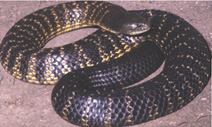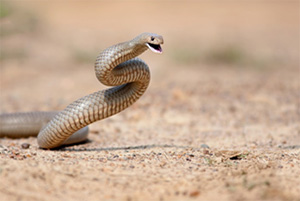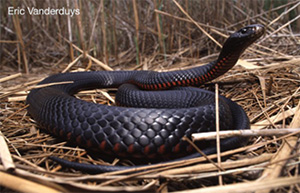Tom Parkinson's monthly column, introducing the diverse range of flora and fauna on show at Sanctuary Lakes.
Snakes and serpents play a role in many of the world's myths and legends. Snakes have long been associated with good as well as evil, representing both life and death, creation and destruction. In the Abrahamic legend, Satan is disguised as a Snake when he entered the Garden of Eden. In contrast, the Aboriginal people of northern Australia tell how the Great Rainbow Snake Julunggul shaped the world. When human blood dropped into a waterhole, Julunggul grew angry. He sent a wave of water washing across the earth, and he swallowed people, plants, and animals. Julunggul reared up toward heaven, but an ant spirit bit him and made him vomit up what he had swallowed. This happened again and again until Julunggul departed from the earth, leaving people, plants, and animals in all parts of it.
In reality snakes are equally if not more fascinating creatures than their mystical forbearers. Firstly, snakes are ectotherms or as commonly termed - cold-blooded. Unlike mammals, they do not rely on cellular metabolism to maintain their temperature. Instead they obtain their heat from external sources, such as the sun. Some species of snakes can go up to 12 months without eating and as a result can live in areas where food in not plentiful. Snakes have a scaly skin and directly related to growth rate will shed their outer layer of skin intermittently. Like many reptiles they will continue growing throughout their lives. Snakes feed on a variety of prey including mammals, birds, reptiles, amphibians, fish and invertebrates. All food items are swallowed whole, so food size is important. Snakes breed annually, producing twenty to thirty live young in membranous sacs eggs, from which they emerge minutes after birth. Newborns can measure as small as 10-15 cm.
Snakes are a relatively common sight on Sanctuary Lakes Resort, particularly around the fresh water ponds and the rough of the Golf Course. I always feel fortunate to view a snake or two as I hack my way around the course. I recently shocked an English visitor, as we closely observed two beautifully marked tiger snakes wiggling their way along the 8th fairway, demonstrating that snakes are absolutely harmless and do not attack unless stepped upon or harassed.
The most common snakes on the Sanctuary Lakes Resort are:
 The Mainland Tiger Snake, the Eastern Brown Snake and the Red-bellied Black Snake.
The Mainland Tiger Snake, the Eastern Brown Snake and the Red-bellied Black Snake.
Mainland Tiger Snake (Notechis scutatis) - generally seen close to the fresh water ponds within the Golf Course, Skeleton Creek and the Wetlands; enjoys sheltering beneath logs, rocks, surface debris, old tree stumps and if available unused burrows.
Tiger Snakes are beautiful looking animals coming in a range of colours & markings and may or may not always be banded. Colours range from greenish browns, olive, reddish brown to jet black. The pale cross bands may be greenish white, greyish to yellow, unfortunately a brilliant camouflage to Golfers searching for their wayward balls in the pond's reeds or under branches.
Although Tiger snakes will attempt to flee if disturbed or encountered, they will aggressively defend themselves if they feel cornered or threatened. Tigers have poor eyesight, so are more likely to be trodden on than other snakes.
The diet of the Mainland Tiger Snake consists of frogs, tadpoles, fish including eels, lizards, birds that are nestling in low lying shrubs and mice. Although this snake is mainly active during the day, it can be encountered on warm to hot evenings.
The tiger snake generally has litters of 15 to 30 being live born from January to April, but litters of more than 100 have been recorded. There are records of Tigers growing up to 2.1metres. Personally I have never seen a Tiger Snake larger than one metre on Sanctuary Lakes Resort.
 Eastern Brown Snake (Pseudonaja textilis) - a fast and aggressive snake with good eyesight, it is the most dangerous snake in eastern Australia and is considered the world's second most venomous land snake.
Eastern Brown Snake (Pseudonaja textilis) - a fast and aggressive snake with good eyesight, it is the most dangerous snake in eastern Australia and is considered the world's second most venomous land snake.
Although Eastern Brown Snakes are temperamental and dangerous creatures, they will always try and avoid a confrontation with humans if possible. There is certainly no advantage for the snake in attacking something as large as a person so they will only do this as a last resort. Given the opportunity, even brown snakes will flee rather than attack. So when observing, stand back and give them plenty of room to escape.
A large adult brown snake is a formidable creature. On hot days, it can move at surprising speed. It has a slender body and is variable in colour ranging from uniform tan to grey or dark brown. The belly is cream, yellow or pale orange with darker orange spots.
Despite the Eastern Brown's reputation, it still performs a very useful function for the Resort as its main diet is rats, mice and small rabbits. Their aggressive appetite saves the entire Resort from being overrun by swarms of rodents and rabbits.
Their natural habitat is heath land. Therefore the golf course is an ideal home and with plenty of their favourite food, they keep a healthy balance for all the Resort.
Eastern Browns will mate in spring and will produce one or two clutches of up to 30 eggs in late spring early summer. The average life span is seven years.
 Red-bellied Black Snake (Pseudechis porphyriacus) - a large snake but not aggressive, often seen near the Resort's golf ponds and the Skeleton Creek area. I was lucky enough to see a magnificent Red Belly Black lying in the sun adjacent to the third tee. It was all of two and a half metres. Strangely neither I, nor my playing partner, realised due its size that it was a snake. It was only when upon hearing us approach, that it quickly slithered away we became aware that it was not a very long wind swept piece of black plastic, but the beautiful serpent shape of a Red-bellied Black.
Red-bellied Black Snake (Pseudechis porphyriacus) - a large snake but not aggressive, often seen near the Resort's golf ponds and the Skeleton Creek area. I was lucky enough to see a magnificent Red Belly Black lying in the sun adjacent to the third tee. It was all of two and a half metres. Strangely neither I, nor my playing partner, realised due its size that it was a snake. It was only when upon hearing us approach, that it quickly slithered away we became aware that it was not a very long wind swept piece of black plastic, but the beautiful serpent shape of a Red-bellied Black.
The Red Belly can be dangerously venomous but bites are rare because it is usually a placid and fairly docile snake, preferring to enact a lengthy bluff display with flattened neck and deep hisses rather than bite. It grows to a length of 2.5 to 3 metres, and is a very distinctive snake because of its simple and unvarying coloration. The upper surface of this snake is glossy black while the belly is light pink to brilliant red.
The Red-bellied Black prefers the swampy, moist areas around ponds, creeks and lakes. They prey on frogs, toads, lizards and even birds, as well as fish and eels. They are good swimmers and have been known to swim underwater for up to 20 minutes.
Like the other snakes in Sanctuary Lakes, Red Belly breeds in the spring and produces one or two clutches of 20 to 30 eggs in the early summer.
These three, the Tiger, the Brown and the Red-bellied are the only snakes I have seen on the Resort. Although the Little Whip snake is common on the basalt western plains, it has, according to the Wyndham Snake Catcher Department, never been seen or reported in the Point Cook area.
Remember, all snakes in the Sanctuary Lakes Resort are venomous - but they will only bite if handled, stepped on or harassed. You are more likely to die from allergic reactions to bee stings than from being bitten by a snake unless of course you walk around the swampy ponds inebriated with bare feet. Fortunately, snakes teeth are short (1cm) and appropriate thick clothing and footwear will usually prevent the venom actually entering the bite and even that will only occur in less than 10% of bites.
Therefore if you are in a likely snake habitat, always wear appropriate clothing and footwear. Watch where you are walking, especially near creeks, and avoid long grass which obscures visibility. Our snakes do not climb so its eyes on the ground.
But even after all this you are still bitten:
- apply a firm bandage around the bite site and extend up the limb (not too tight that it cuts the blood supply off, you just want to stop the lymph draining)
- splint the limb, do not exert yourself unnecessarily
- do not try to capture or kill the snake (they are protected species and you will only risk getting bitten again)
- do not drink alcohol or take drugs or medications
- do not wash the wound or try to suck the poison out (doctors will want to use the bite site to determine which snake it was and what is the appropriate anti-venom to use if needed)
- Get to medical help as soon as possible without causing a car accident on the way, so don't drive unless it is a last resort. If you follow the first aid measures above, you should have at least a few hours to get to medical help - you should also consider requesting ambulance help.
Always remember that snakes are not out there to get us. They are a vital part of the environment that supports us and they called Australia home long before we did. Snakes are an essential part of Nature's Rubik. Without snakes balancing predators, the Sanctuary Lakes residents would not have their high standard, healthy lifestyle and safe environment. Also Australia would not have the booming agricultural industries that we depend on.